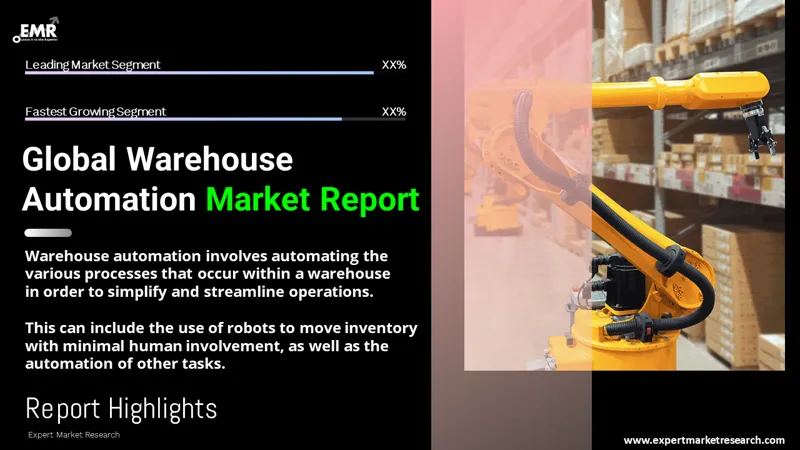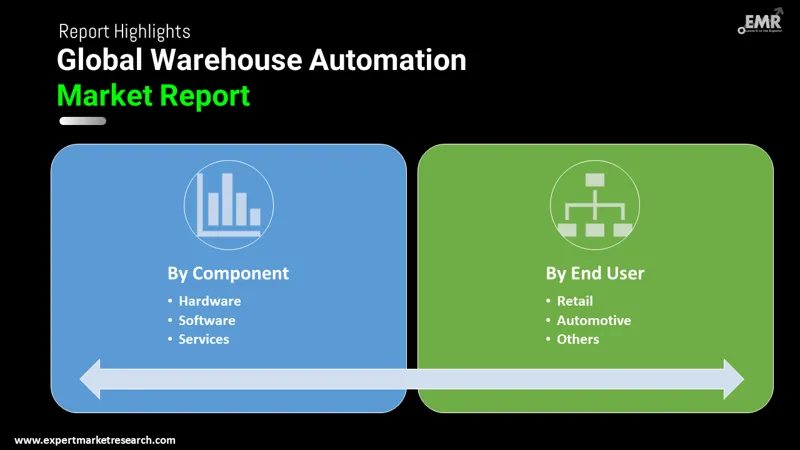
Consumer Insights
Uncover trends and behaviors shaping consumer choices today
Procurement Insights
Optimize your sourcing strategy with key market data
Industry Stats
Stay ahead with the latest trends and market analysis.
The warehouse automation market size attained a value of USD 23.16 Billion in 2025. The market is further expected to grow at a CAGR of 15.00% between 2026 and 2035, to reach a value of USD 93.70 Billion by 2035.
Base Year
Historical Period
Forecast Period
Compound Annual Growth Rate
15%
Value in USD Billion
2026-2035
*this image is indicative*
| Global Warehouse Automation Market Report Summary | Description | Value |
| Base Year | USD Billion | 2025 |
| Historical Period | USD Billion | 2019-2025 |
| Forecast Period | USD Billion | 2026-2035 |
| Market Size 2025 | USD Billion | 23.16 |
| Market Size 2035 | USD Billion | 93.70 |
| CAGR 2019-2025 | Percentage | XX% |
| CAGR 2026-2035 | Percentage | 15.00% |
| CAGR 2026-2035 - Market by Region | Asia Pacific | 17.3% |
| CAGR 2026-2035 - Market by Country | India | 19.8% |
| CAGR 2026-2035 - Market by Country | China | 16.6% |
| CAGR 2026-2035 - Market by Component | Hardware | 16.8% |
| CAGR 2026-2035 - Market by End User | Food and Beverage | 17.1% |
| Market Share by Country 2025 | India | 3.7% |
Warehouse automation refers to the automation of processes that take place within a warehouse and are designed to make warehouse operations easier and more efficeicnt. The warehouse automation can be used to move inventories, minimal human intervention and perform other topics with the use of robots. Warehouse automation uses various internet-enabled devices and hardware and software components to carry out numerous warehousing operations at remarkable speeds and efficiency.

Read more about this report - REQUEST FREE SAMPLE COPY IN PDF
The EMR’s report titled “Global Warehouse Automation Market Report and Forecast 2026-2035” offers a detailed analysis of the market based on the following segments:
Market Breakup by Component
Market Breakup by End User
Market Breakup by Region

Read more about this report - REQUEST FREE SAMPLE COPY IN PDF
The software segment, based on component, accounts for a healthy share of the warehouse automation market as increasing adoption of advanced warehouse automation software reduces chances of human error, drives down operational costs, and enhances productivity. In addition, warehouse automation software minimises data entry error while reducing excess of hours put in the data entry process. The emergence of warehouse automation software with additional features for enhanced data management, accelerated workflow, and greater support quality, is anticipated to add to the market numbers in the forecast period.
North America holds a significant share of the warehouse automation market, driven by rapid digitalisation across various end use sectors and rising demand for warehouse automation to optimise space and inventory management systems. Well-established network of warehouse automation services providers across the region and increasing costs of labour are likely to offer expanded opportunities for the warehouse automation market in the coming years.
| CAGR 2026-2035 - Market by | Country |
| India | 19.8% |
| China | 16.6% |
| UK | 13.7% |
| USA | 13.4% |
| Italy | 10.5% |
| Canada | XX% |
| Germany | XX% |
| France | XX% |
| Japan | 10.3% |
| Australia | XX% |
| Saudi Arabia | XX% |
| Brazil | XX% |
| Mexico | XX% |
The comprehensive EMR report provides an in-depth assessment of the market based on the Porter's five forces model along with giving a SWOT analysis. The report gives a detailed analysis of the key players in the global warehouse automation market, covering their competitive landscape and latest developments like mergers, acquisitions, investments and expansion plans.
ABB LTD, is a leading automation company which has a vast portfolio, including control room solutions, drives, industrial software, low voltage products and systems, measurement and analytics, motors and generators, and robotics, among others. Founded in 1988 and headquartered in Zurich, Switzerland, this company provides advanced electrified solutions which optimise industrial operations.
KION Group AG is a multinational manufacturer with a product portfolio that includes warehouse trucks, hand pallet trucks, driver assistance systems, and financing and leasing solutions. The company was established in 2006 and is headquartered in Frankfurt, Germany.
Daifuku Co., Ltd., is a prominent material handling equipment company which designs, manufactures, and sells a variety of automated systems, such as automated storage, conveyor, and sorters. This company was founded in 1937 and is headquartered in Osaka, Japan.
*Please note that this is only a partial list; the complete list of key players is available in the full report. Additionally, the list of key players can be customized to better suit your needs.*
Other market players include Fanuc Corporation, Honeywell International Inc., Jungheinrich AG, Kuka AG, KNAPP AG, Oracle Corporation, SAP SE, Mecalux, S.A., and BEUMER Maschinenfabrik GmbH & Co. KG, among others.




*While we strive to always give you current and accurate information, the numbers depicted on the website are indicative and may differ from the actual numbers in the main report. At Expert Market Research, we aim to bring you the latest insights and trends in the market. Using our analyses and forecasts, stakeholders can understand the market dynamics, navigate challenges, and capitalize on opportunities to make data-driven strategic decisions.*
Get in touch with us for a customized solution tailored to your unique requirements and save upto 35%!
The market reached a value of USD 23.16 Billion in 2025.
The market is estimated to grow at a CAGR of 15.00% between 2026 and 2035.
The market is estimated to witness a healthy growth between the forecast period of 2026-2035 to reach a value of USD 93.70 Billion by 2035.
The increasing demand for collaborative robots and cloud-based warehouse automation software, growing efforts by retailers and various end users towards streamlining inventory operations, and rising awareness about the benefits of warehouse automation are the major drivers of the market.
The key warehouse automation market trends include the thriving e-commerce sector and increasing adoption of advanced warehouse automation technologies.
Hardware, software, and services are the different components of warehouse automation in the market, with hardware further classified into robots, and storage and retrieval systems, among others.
Food and beverage, post and parcel, automotive, retail, and pharmaceuticals, among others, are major end users of warehouse automation in the market.
ABB LTD, KION Group AG, Daifuku Co., Ltd., Fanuc Corporation, Honeywell International Inc., Jungheinrich AG, Kuka AG, KNAPP AG, Oracle Corporation, SAP SE, Mecalux, S.A., and BEUMER Maschinenfabrik GmbH & Co. KG, among others, are the key players of the warehouse automation market, according to the report.
Explore our key highlights of the report and gain a concise overview of key findings, trends, and actionable insights that will empower your strategic decisions.
| REPORT FEATURES | DETAILS |
| Base Year | 2025 |
| Historical Period | 2019-2025 |
| Forecast Period | 2026-2035 |
| Scope of the Report |
Historical and Forecast Trends, Industry Drivers and Constraints, Historical and Forecast Market Analysis by Segment:
|
| Breakup by Component |
|
| Breakup by End User |
|
| Breakup by Region |
|
| Market Dynamics |
|
| Competitive Landscape |
|
| Companies Covered |
|
Datasheet
One User
USD 2,499
USD 2,249
tax inclusive*
Single User License
One User
USD 3,999
USD 3,599
tax inclusive*
Five User License
Five User
USD 4,999
USD 4,249
tax inclusive*
Corporate License
Unlimited Users
USD 5,999
USD 5,099
tax inclusive*
*Please note that the prices mentioned below are starting prices for each bundle type. Kindly contact our team for further details.*
Flash Bundle
Small Business Bundle
Growth Bundle
Enterprise Bundle
*Please note that the prices mentioned below are starting prices for each bundle type. Kindly contact our team for further details.*
Flash Bundle
Number of Reports: 3
20%
tax inclusive*
Small Business Bundle
Number of Reports: 5
25%
tax inclusive*
Growth Bundle
Number of Reports: 8
30%
tax inclusive*
Enterprise Bundle
Number of Reports: 10
35%
tax inclusive*
How To Order

Select License Type
Choose the right license for your needs and access rights.

Click on ‘Buy Now’
Add the report to your cart with one click and proceed to register.

Select Mode of Payment
Choose a payment option for a secure checkout. You will be redirected accordingly.
Gain insights to stay ahead and seize opportunities.

Get insights & trends for a competitive edge.

Track prices with detailed trend reports.

Analyse trade data for supply chain insights.

Leverage cost reports for smart savings

Enhance supply chain with partnerships.

Connect For More Information
Our expert team of analysts will offer full support and resolve any queries regarding the report, before and after the purchase.
Our expert team of analysts will offer full support and resolve any queries regarding the report, before and after the purchase.
We employ meticulous research methods, blending advanced analytics and expert insights to deliver accurate, actionable industry intelligence, staying ahead of competitors.
Our skilled analysts offer unparalleled competitive advantage with detailed insights on current and emerging markets, ensuring your strategic edge.
We offer an in-depth yet simplified presentation of industry insights and analysis to meet your specific requirements effectively.
Share